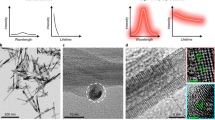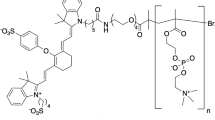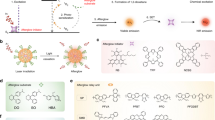Abstract
Photoacoustic imaging holds great promise for the visualization of physiology and pathology at the molecular level with deep tissue penetration and fine spatial resolution. To fully utilize this potential, photoacoustic molecular imaging probes have to be developed. Here, we introduce near-infrared light absorbing semiconducting polymer nanoparticles as a new class of contrast agents for photoacoustic molecular imaging. These nanoparticles can produce a stronger signal than the commonly used single-walled carbon nanotubes and gold nanorods on a per mass basis, permitting whole-body lymph-node photoacoustic mapping in living mice at a low systemic injection mass. Furthermore, the semiconducting polymer nanoparticles possess high structural flexibility, narrow photoacoustic spectral profiles and strong resistance to photodegradation and oxidation, enabling the development of the first near-infrared ratiometric photoacoustic probe for in vivo real-time imaging of reactive oxygen species—vital chemical mediators of many diseases. These results demonstrate semiconducting polymer nanoparticles to be an ideal nanoplatform for developing photoacoustic molecular probes.
This is a preview of subscription content, access via your institution
Access options
Subscribe to this journal
Receive 12 print issues and online access
$259.00 per year
only $21.58 per issue
Buy this article
- Purchase on Springer Link
- Instant access to full article PDF
Prices may be subject to local taxes which are calculated during checkout





Similar content being viewed by others
References
Mei, J., Diao, Y., Appleton, A. L., Fang, L. & Bao, Z. Integrated materials design of organic semiconductors for field-effect transistors. J. Am. Chem. Soc. 135, 6724–6746 (2013).
Peet, J. et al. Efficiency enhancement in low-bandgap polymer solar cells by processing with alkane dithiols. Nature Mater. 6, 497–500 (2007).
Sokolov, A. N., Tee, B. C. K., Bettinger, C. J., Tok, J. B. H. & Bao, Z. N. Chemical and engineering approaches to enable organic field-effect transistors for electronic skin applications. Acc. Chem. Res. 45, 361–371 (2012).
Rose, A., Zhu, Z., Madigan, C. F., Swager, T. M. & Bulovic, V. Sensitivity gains in chemosensing by lasing action in organic polymers. Nature 434, 876–879 (2005).
Sanghvi, A. B., Miller, K. P., Belcher, A. M. & Schmidt, C. E. Biomaterials functionalization using a novel peptide that selectively binds to a conducting polymer. Nature Mater. 4, 496–502 (2005).
Wu, C. & Chiu, D. T. Highly fluorescent semiconducting polymer dots for biology and medicine. Angew. Chem. Int. Ed. 52, 3086–3109 (2013).
Zhu, C., Liu, L., Yang, Q., Lv, F. & Wang, S. Water-soluble conjugated polymers for imaging, diagnosis, and therapy. Chem. Rev. 112, 4687–4735 (2012).
Xiong, L., Shuhendler, A. J. & Rao, J. Self-luminescing BRET-FRET near-infrared dots for in vivo lymph-node mapping and tumour imaging. Nature Commun. 3, 1193 (2012).
Pu, K. Y. & Liu, B. Fluorescent conjugated polyelectrolytes for bioimaging. Adv. Funct. Mater. 21, 3408–3423 (2011).
Wang, L. V. & Hu, S. Photoacoustic tomography: in vivo imaging from organelles to organs. Science 335, 1458–1462 (2012).
Ntziachristos, V. & Razansky, D. Molecular imaging by means of multispectral optoacoustic tomography (MSOT). Chem. Rev. 110, 2783–2794 (2010).
Kim, C., Favazza, C. & Wang, L. H. V. In vivo photoacoustic tomography of chemicals: high-resolution functional and molecular optical imaging at new depths. Chem. Rev. 110, 2756–2782 (2010).
Eghtedari, M. et al. High sensitivity of in vivo detection of gold nanorods using a laser optoacoustic imaging system. Nano Lett. 7, 1914–1918 (2007).
De la Zerda, A. et al. Carbon nanotubes as photoacoustic molecular imaging agents in living mice. Nature Nanotech. 3, 557–562 (2008).
Kim, J. W., Galanzha, E. I., Shashkov, E. V., Moon, H. M. & Zharov, V. P. Golden carbon nanotubes as multimodal photoacoustic and photothermal high-contrast molecular agents. Nature Nanotech. 4, 688–694 (2009).
Lovell, J. F. et al. Porphysome nanovesicles generated by porphyrin bilayers for use as multimodal biophotonic contrast agents. Nature Mater. 10, 324–332 (2011).
Akers, W. J. et al. Noninvasive photoacoustic and fluorescence sentinel lymph node identification using dye-loaded perfluorocarbon nanoparticles. ACS Nano 5, 173–182 (2011).
Xia, Y. N. et al. Gold nanocages: from synthesis to theranostic applications. Acc. Chem. Res. 44, 914–924 (2011).
Jokerst, J. V., Cole, A. J., Van de Sompel, D. & Gambhir, S. S. Gold nanorods for ovarian cancer detection with photoacoustic imaging and resection guidance via Raman imaging in living mice. ACS Nano 6, 10366–10377 (2012).
Lovell, J. F., Liu, T. W., Chen, J. & Zheng, G. Activatable photosensitizers for imaging and therapy. Chem. Rev. 110, 2839–2857 (2010).
Razgulin, A., Ma, N. & Rao, J. H. Strategies for in vivo imaging of enzyme activity: an overview and recent advances. Chem. Soc. Rev. 40, 4186–4216 (2011).
Weissleder, R. & Ntziachristos, V. Shedding light onto live molecular targets. Nature Med. 9, 123–128 (2003).
Melancon, M. P., Zhou, M. & Li, C. Cancer theranostics with near-infrared light-activatable multimodal nanoparticles. Acc. Chem. Res. 44, 947–956 (2011).
Levi, J. et al. Molecular photoacoustic imaging of follicular thyroid carcinoma. Clin. Cancer Res. 19, 1494–1502 (2013).
Levi, J. et al. Design, synthesis, and imaging of an activatable photoacoustic probe. J. Am. Chem. Soc. 132, 11264–11269 (2010).
Zhang, Y., Hong, H. & Cai, W. Photoacoustic imaging. Cold Spring Harb. Protoc. http://dx.doi.org/10.1101/pdb.top065508 (2011).
Medzhitov, R. Origin and physiological roles of inflammation. Nature 454, 428–435 (2008).
Szabo, C., Ischiropoulos, H. & Radi, R. Peroxynitrite: biochemistry, pathophysiology and development of therapeutics. Nature Rev. Drug Discov. 6, 662–680 (2007).
Muhlbacher, D. et al. High photovoltaic performance of a low-bandgap polymer. Adv. Mater. 18, 2884–2889 (2006).
Pramanik, M., Swierczewska, M., Green, D., Sitharaman, B. & Wang, L. V. Single-walled carbon nanotubes as a multimodal-thermoacoustic and photoacoustic-contrast agent. J. Biomed. Opt. 14, 034018 (2009).
Link, S., Burda, C., Nikoobakht, B. & El-Sayed, M. A. Laser-induced shape changes of colloidal gold nanorods using femtosecond and nanosecond laser pulses. J. Phys. Chem. B 104, 6152–6163 (2000).
Kim, S. et al. Near-infrared fluorescent type II quantum dots for sentinel lymph node mapping. Nature Biotechnol. 22, 93–97 (2004).
Nakajima, M., Takeda, M., Kobayashi, M., Suzuki, S. & Ohuchi, N. Nano-sized fluorescent particles as new tracers for sentinel node detection: experimental model for decision of appropriate size and wavelength. Cancer Sci. 96, 353–356 (2005).
Oushiki, D. et al. Development and application of a near-infrared fluorescence probe for oxidative stress based on differential reactivity of linked cyanine dyes. J. Am. Chem. Soc. 132, 2795–2801 (2010).
Kim, G., Lee, Y. E., Xu, H., Philbert, M. A. & Kopelman, R. Nanoencapsulation method for high selectivity sensing of hydrogen peroxide inside live cells. Anal. Chem. 82, 2165–2169 (2010).
Winterbourn, C. C. & Metodiewa, D. Reactivity of biologically important thiol compounds with superoxide and hydrogen peroxide. Free Radic. Biol. Med. 27, 322–328 (1999).
Zhao, G. et al. Pivotal role of reactive oxygen species in differential regulation of lipopolysaccharide-induced prostaglandins production in macrophages. Mol. Pharmacol. 83, 167–178 (2013).
Guimard, N. K., Gomez, N. & Schmidt, C. E. Conducting polymers in biomedical engineering. Prog. Polym. Sci. 32, 876–921 (2007).
Dickinson, B. C. & Chang, C. J. Chemistry and biology of reactive oxygen species in signaling or stress responses. Nature Chem. Biol. 7, 504–511 (2011).
Nagano, T. Bioimaging probes for reactive oxygen species and reactive nitrogen species. J. Clin. Biochem. Nutr. 45, 111–124 (2009).
Acknowledgements
The authors acknowledge the use of the SCi3 Core Facility. This work was supported by the National Institutes of Health (grants 2R01DK099800-06 and R21CA138353A2), the Stanford University National Cancer Institute (NCI) CCNE-T grant (U54CA151459) and In Vivo Cellular and Molecular Imaging Center (ICMIC) grant (P50CA114747). A.J.S. thanks the Susan G. Komen for the Cure for fellowship support. J.V.J. acknowledges a grant from NCI (5R25CA11868) and was supported by a postdoctoral fellowship (PF-13-098-01–CCE) from the American Cancer Society. J.M. and Z.B. acknowledge support from Air Force Office of Scientific Research for support of the synthesis of the polymers (FA9550-12-1-0190).
Author information
Authors and Affiliations
Contributions
K.P., A.J.S. and J.R. conceived of the experiments. K.P. synthesized and characterized the nanoparticles. K.P. and A.J.S. performed in vitro and in vivo experiments. J.J. and S.S.G. provided GNRs, SWNTs and technical assistance with photoacoustic imaging. J.M. and Z.B. synthesized and provided SP2. K.P., A.J.S. and J.R. analysed the data and wrote the manuscript. All authors commented and contributed to the manuscript.
Corresponding author
Ethics declarations
Competing interests
S.S.G. serves on the board of Endra and serves as a consultant for Visualsonics, both manufacturers of small animal photoacoustic imaging equipment.
Supplementary information
Supplementary information
Supplementary information (PDF 4227 kb)
Rights and permissions
About this article
Cite this article
Pu, K., Shuhendler, A., Jokerst, J. et al. Semiconducting polymer nanoparticles as photoacoustic molecular imaging probes in living mice. Nature Nanotech 9, 233–239 (2014). https://doi.org/10.1038/nnano.2013.302
Received:
Accepted:
Published:
Issue Date:
DOI: https://doi.org/10.1038/nnano.2013.302
This article is cited by
-
Near-infrared photodynamic and photothermal co-therapy based on organic small molecular dyes
Journal of Nanobiotechnology (2023)
-
Nanomaterial-based contrast agents
Nature Reviews Methods Primers (2023)
-
Near-infrared-II photoacoustic imaging and photo-triggered synergistic treatment of thrombosis via fibrin-specific homopolymer nanoparticles
Nature Communications (2023)
-
In situ self-assembly for cancer therapy and imaging
Nature Reviews Materials (2023)
-
Thirty years of research on photoacoustic imaging in the field of cancer: A scientometric analysis of hotspots, bursts, and research trends
Environmental Science and Pollution Research (2023)



